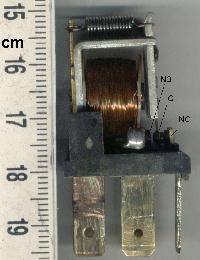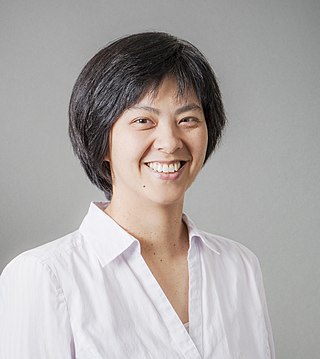
MEMS is the technology of microscopic devices incorporating both electronic and moving parts. MEMS are made up of components between 1 and 100 micrometres in size, and MEMS devices generally range in size from 20 micrometres to a millimetre, although components arranged in arrays can be more than 1000 mm2. They usually consist of a central unit that processes data and several components that interact with the surroundings.

Microfabrication is the process of fabricating miniature structures of micrometre scales and smaller. Historically, the earliest microfabrication processes were used for integrated circuit fabrication, also known as "semiconductor manufacturing" or "semiconductor device fabrication". In the last two decades, microelectromechanical systems (MEMS), microsystems, micromachines and their subfields have re-used, adapted or extended microfabrication methods. These subfields include microfluidics/lab-on-a-chip, optical MEMS, RF MEMS, PowerMEMS, BioMEMS and their extension into nanoscale. The production of flat-panel displays and solar cells also uses similar techniques.
Micropower describes the use of very small electric generators and prime movers or devices to convert heat or motion to electricity, for use close to the generator. The generator is typically integrated with microelectronic devices and produces "several watts of power or less." These devices offer the promise of a power source for portable electronic devices which is lighter weight and has a longer operating time than batteries.
Rudra Pratap is an Indian academician and the vice-chancellor of Plaksha University, Mohali. Previously, he was a professor of Mechanical Engineering at the Indian Institute of Science (IISc), Bangalore. Among other research interests, he works in the field of Microelectromechanical systems (MEMS) and used to head India's first research lab in the field of Microelectromechanical systems, the CranesSci MEMS Lab at Indian Institute of Science, Bangalore. His book on MATLAB Getting Started with MATLAB 7 is popular among the students of engineering. He is also the Chair for the Centre of Nanoscience and Engineering (CeNSE).

Electromechanics combines processes and procedures drawn from electrical engineering and mechanical engineering. Electromechanics focuses on the interaction of electrical and mechanical systems as a whole and how the two systems interact with each other. This process is especially prominent in systems such as those of DC or AC rotating electrical machines which can be designed and operated to generate power from a mechanical process (generator) or used to power a mechanical effect (motor). Electrical engineering in this context also encompasses electronics engineering.
MEMS for in situ mechanical characterization refers to microelectromechanical systems (MEMS) used to measure the mechanical properties of nanoscale specimens such as nanowires, nanorods, whiskers, nanotubes and thin films. They distinguish themselves from other methods of nanomechanical testing because the sensing and actuation mechanisms are embedded and/or co-fabricated in the microsystem, providing—in the majority of cases—greater sensitivity and precision.
Mark G. Allen is a professor specializing in microfabrication, nanotechnology, and microelectromechanical systems at the University of Pennsylvania, where he is currently Alfred Fitler Moore Professor of Electrical and Systems Engineering Director of the Singh Center for Nanotechnology, and leader of the Microsensor and Microactuator Research Group. Prior to his joining the University of Pennsylvania in 2013, he was with the Georgia Institute of Technology, where he was Regents' Professor of Electrical and Computer Engineering and the J.M. Pettit Professor in Microelectronics. While at Georgia Tech, he also held multiple administrative positions, including Senior Vice Provost for Research and Innovation; Acting Director of the Georgia Electronic Design Center; and Inaugural Executive Director of Georgia Tech's Institute for Electronics and Nanotechnology. He was editor in chief of the Journal of Micromechanics and Microengineering (JMM), and currently serves on the editorial board of JMM as well as the journal Microsystems and Nanoengineering.
Microelectromechanical system oscillators are devices that generate highly stable reference frequencies used to sequence electronic systems, manage data transfer, define radio frequencies, and measure elapsed time. The core technologies used in MEMS oscillators have been in development since the mid-1960s, but have only been sufficiently advanced for commercial applications since 2006. MEMS oscillators incorporate MEMS resonators, which are microelectromechanical structures that define stable frequencies. MEMS clock generators are MEMS timing devices with multiple outputs for systems that need more than a single reference frequency. MEMS oscillators are a valid alternative to older, more established quartz crystal oscillators, offering better resilience against vibration and mechanical shock, and reliability with respect to temperature variation.
Zeynep Çelik-Butler is a Turkish-American professor of electrical engineering at the Nanotechnology Research and Teaching Facility within the College of Engineering at the University of Texas at Arlington. There are two distinctly different areas of research within the group.

Rashid Bashir is Dean of The Grainger College of Engineering, Grainger Distinguished Chair in Engineering and Professor of Bioengineering, at the University of Illinois Urbana-Champaign. He was the Executive Associate Dean and Chief Diversity Officer at the Carle-Illinois College of Medicine at UIUC. Previously, he was the Abel Bliss Professor of Engineering.
Chih-Kung Lee is a Taiwanese mechanical engineer.

Richard Stephen Muller is an American professor in the Electrical Engineering and Computer Science Department of the University of California at Berkeley.

Nam-Trung Nguyen is a Vietnamese-Australian researcher in the fields of Microfluidics and Nanofluidics. He is notable for his work on nerve agent detector, PCR, Micromixer, Droplet-based Microfluidics, Micro Magnetofluidics, Liquid Marbles and Micro Elastofluidics. He is currently a Professor and Director of Queensland Micro and Nanotechnology Centre at Griffith University. He was a former Associate Professor at Nanyang Technological University, Singapore. Nguyen is a Fellow of ASME and a Senior Member of IEEE.

Roger Thomas Howe is the William E. Ayer Professor of Electrical Engineering at Stanford University. He earned a B.S. degree in physics from Harvey Mudd College and M.S. and Ph.D. degrees in electrical engineering from the University of California, Berkeley in 1981 and 1984, respectively. He was a faculty member at Carnegie-Mellon University from 1984-1985, at the Massachusetts Institute of Technology from 1985-1987, and at UC Berkeley between 1987-2005, where he was the Robert S. Pepper Distinguished Professor. He has been a faculty member of the School of Engineering at Stanford since 2005.

Reza Ghodssi is a Professor in the Department of Electrical and Computer Engineering and the Institute for Systems Research (ISR) at the University of Maryland, College Park, where he directs the MEMS Sensors and Actuators Lab and holds the Herbert Rabin Distinguished Chair in Engineering. Ghodssi is also the Inaugural Executive Director of Research and Innovation for the A. James Clark School of Engineering at the University System of Maryland at Southern Maryland (USMSM). He is best known for his work designing micro- and nano-devices for healthcare applications, particularly for systems requiring small-scale energy conversion and biological and chemical sensing.

Ellis Meng is the Shelly and Ofer Nemirovsky Chair of Convergent Biosciences and Professor of Biomedical Engineering and Electrical and Computer Engineering in the Viterbi School of Engineering at the University of Southern California, where she also serves as the Vice Dean of Technology Innovation and Entrepreneurship. Meng is highly decorated in the development of novel micro- and nanotechnologies for biomedical applications. In 2009, Meng was named on MIT Technology Review's "Innovators Under 35" List for her work on micropumps that deliver drugs preventing blindness, and she was listed on the 40 Under 40 List of the Medical Device and Diagnostic Industry (MDDI) in 2012.

Xin Zhang is a Distinguished Professor of Engineering at Boston University (BU).
Roya Maboudian is distinguished professor of chemical and biomolecular engineering at the University of California, Berkeley, and co-director of the Berkeley Sensor and Actuator Center. She also holds The John F. Heil, Jr. Chancellor's Chair in Chemical & Biomolecular Engineering, and is the Associate Dean of Undergraduate Affairs in the College of Chemistry at UC Berkeley. She has served as editor of the IEEE Journal of Microelectromechanical Systems and ACS Sensors, and as associate editor of IEEE/SPIE Journal on Microfabrication, Microlithography and Microsystems.

Niels Quack is a Swiss and German engineer specialized in optical micro engineering. He is a SNSF professor at EPFL and director of the Photonic Micro- and Nanosystems Laboratory at its school of engineering.
Pritiraj Mohanty is a physicist and entrepreneur. He is a professor of physics at Boston University. He is most known for his work on quantum coherence, mesoscopic physics, nanomechanical systems, and nanotechnology with a recent focus on biosensing and nanomechanical computing.









